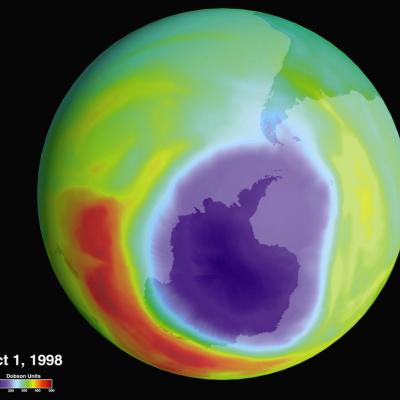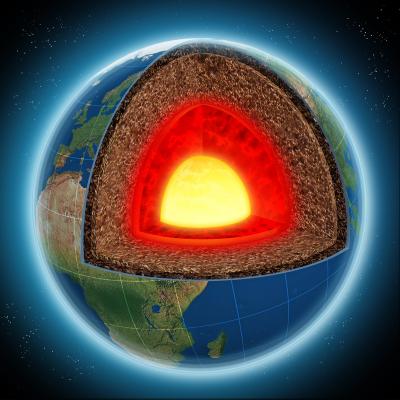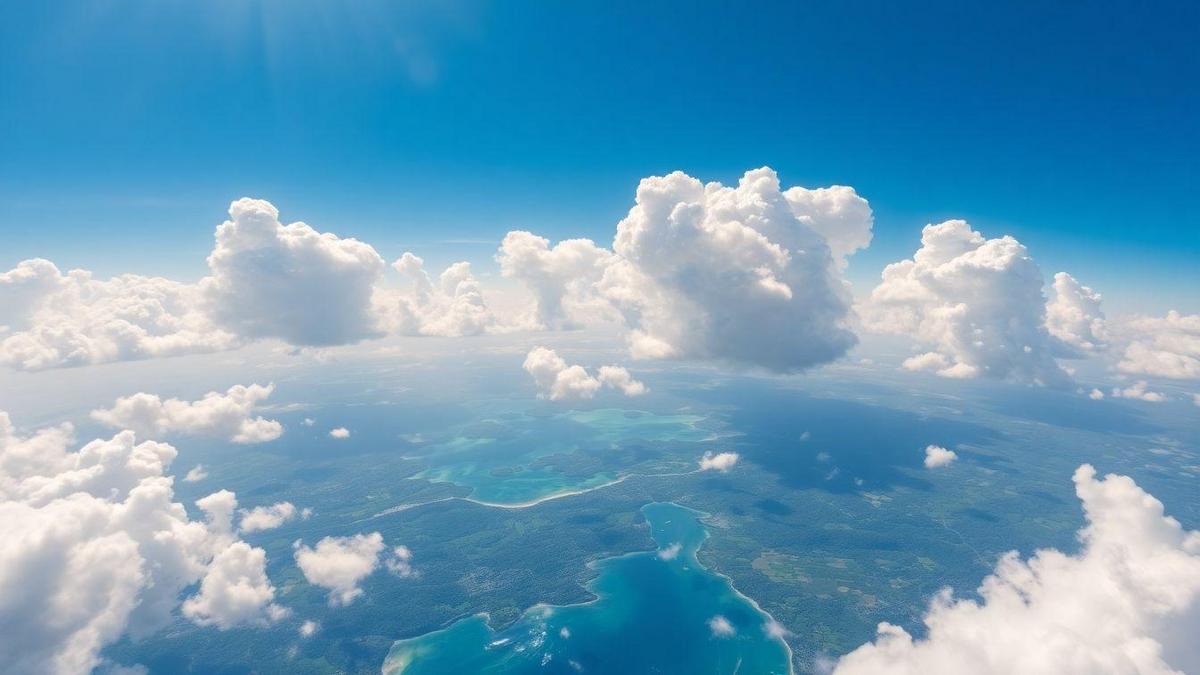Anúncios
The ozone layer is essential for the preservation of life on Earth, as it acts as a shield against harmful ultraviolet rays. Located in the stratosphere, this layer filters solar radiation, protecting human beings, animals, and plants. Understanding how it works is essential to ensure the environmental health of the planet.
In recent years, global recognition of the importance of the ozone layer has driven political and social actions. Public awareness grew with the discovery of the hole over Antarctica, motivating international measures. Protecting this layer has become a common goal of humanity.
Anúncios
How the Ozone Layer Works
The ozone layer is a region of Earth’s stratosphere that contains a high concentration of ozone (O3) molecules. This layer is located approximately 10 to 30 miles above the Earth’s surface and plays a crucial role in protecting life on our planet. Ozone molecules absorb most of the sun’s harmful ultraviolet (UV) radiation, which can lead to skin cancer, cataracts, and other serious health problems in humans and animals. By filtering out these harmful rays, the ozone layer acts as a shield, allowing only safe levels of UV radiation to reach the Earth’s surface.
The functioning of the ozone layer is a complex process that involves the continuous formation and destruction of ozone molecules. Ozone is created when ultraviolet sunlight splits oxygen molecules (O2) into individual oxygen atoms. These free oxygen atoms can then react with other oxygen molecules to form ozone (O3). However, ozone is also broken down by UV radiation, which can lead to a delicate balance between the production and destruction of ozone. This dynamic balance is essential for maintaining the ozone layer’s effectiveness in protecting the Earth from harmful UV radiation.
Furthermore, the ozone layer is not uniform; its thickness varies depending on geographic location and seasonal changes. For example, the ozone layer tends to be thicker at the poles and thinner at the equator. This variation can influence the amount of UV radiation that different regions of the Earth receive, impacting ecosystems and human health in those areas. Understanding how the ozone layer works and its importance in regulating UV radiation is crucial to preserving its integrity and ensuring a healthy environment for all living beings.
In recent years, human activities have significantly impacted the ozone layer, mainly through the release of chlorofluorocarbons (CFCs) and other ozone-depleting substances. These chemicals were used in various applications, including refrigeration, aerosol sprays, and foam production. When released into the atmosphere, CFCs can rise to the stratosphere, where they are broken down by UV radiation, releasing chlorine atoms that can destroy ozone molecules. This process has led to the thinning of the ozone layer, particularly over Antarctica, resulting in what is commonly referred to as the “ozone hole.” Addressing these challenges is critical to the long-term health of the ozone layer and the protection it provides.
Advantages of Recognizing Ozone as Earth’s Atmospheric Protective Layer

Recognizing the ozone layer as Earth’s atmospheric protective layer brings numerous advantages. First and foremost, it raises awareness about the critical role the ozone layer plays in protecting human health and the environment. When people understand the importance of the ozone layer, they are more likely to support policies and initiatives aimed at its protection. This awareness can lead to greater public engagement in environmental issues and motivate individuals to adopt more sustainable practices in their daily lives.
Another significant advantage of recognizing the ozone layer is its potential to foster international cooperation. The global nature of the ozone layer means that its protection requires a collective effort from all nations. The Montreal Protocol, established in 1987, is a prime example of how countries can come together to address a shared environmental challenge. By recognizing the importance of the ozone layer, nations can work collaboratively to reduce the production and consumption of ozone-depleting substances, leading to a healthier atmosphere for all.
Additionally, recognizing the ozone layer’s protective role can drive innovation in green technology. As awareness about the dangers of ozone degradation grows, researchers and companies are motivated to develop alternative products and processes that do not harm the ozone layer. This shift towards sustainable practices can lead to job creation, economic growth, and technological advancements that benefit both the environment and society as a whole.
Finally, recognizing the ozone layer as a protective shield encourages a holistic approach to environmental protection. It highlights the interconnectedness of various environmental issues, such as climate change, air quality, and biodiversity. By understanding that the health of the ozone layer is linked to these broader environmental challenges, individuals, communities, and governments can adopt more comprehensive strategies to address them, ultimately leading to a healthier planet for future generations.
Importance of Recognizing the Ozone Layer
Recognizing the value of the ozone layer strengthens global environmental awareness. When we understand its importance, we are motivated to act responsibly. Education is the first step toward effective protection.
This appreciation has important political and social implications. It encourages legislation and agreements aimed at preserving the atmosphere. Furthermore, it stimulates public engagement with environmental causes.
Recognition also reinforces cooperation between countries. Protecting the ozone layer requires global and coordinated efforts. Joint policies demonstrate that solidarity is possible in environmental matters.
Finally, this awareness promotes sustainable research and innovation. As a result, safe alternatives to harmful compounds are created. Recognizing the importance of ozone is, therefore, a transformative agent.
How to Effectively Protect the Ozone Layer
Protecting the ozone layer is a shared responsibility that requires action from individuals, communities, businesses, and governments. Here are some effective strategies to safeguard this vital atmospheric protective layer:
Reduce air pollution to improve atmospheric protection. Air pollution contributes to ozone layer degradation. By reducing emissions from vehicles, industries, and household activities, we can help minimize the release of ozone-depleting substances into the atmosphere. Simple actions such as using public transportation, carpooling, or adopting cleaner energy sources can make a significant difference.
Support green technology initiatives for ozone synthesis. Investing in green technologies that promote ozone synthesis can help restore the ozone layer. Innovations in renewable energy, sustainable agriculture, and eco-friendly manufacturing processes can reduce the reliance on harmful chemicals and contribute to a healthier atmosphere.
Advocate for policies against ozone degradation. Supporting legislation aimed at phasing out the use of ozone-depleting substances is crucial for protecting the ozone layer. Engaging with local representatives, participating in campaigns, and raising awareness about the importance of the ozone layer can drive meaningful policy changes.
Educate communities about the importance of the ozone layer. Raising awareness about the role of the ozone layer in protecting human health and the environment is essential to promoting a culture of conservation. Educational programs, workshops, and community events can empower individuals to act and make informed decisions about their environmental impact.
Monitor UV radiation levels to assess the impact of climate change. Regularly monitoring UV radiation levels can provide valuable information about the state of the ozone layer and its effectiveness in filtering harmful rays. This data can inform policy decisions and help track progress in ozone layer recovery efforts.
Promote sustainable practices that benefit the environment. Encouraging sustainable practices such as recycling, waste reduction, and energy conservation can contribute to the overall health of the environment and the ozone layer. By making conscious choices in our daily lives, we can collectively work toward a healthier planet.
Protecting the ozone layer is crucial to maintaining a healthy atmosphere and safeguarding life on Earth. By implementing these strategies, we can contribute to the restoration and preservation of this vital protective layer, ensuring a safer environment for current and future generations.
Did You Enjoy Learning About the Recognition of Ozone as Earth’s Atmospheric Protective Layer?

Understanding the role of the ozone layer in atmospheric protection is vital for the future of our planet. By recognizing its importance, we can take steps to preserve it for future generations. The collective efforts of individuals, communities, and governments can have a significant impact on protecting this essential layer of our atmosphere.
We hope this article inspires you to explore more about environmental protection and the critical role of the ozone layer. As we continue to learn and advocate for the health of our planet, every action counts to ensure a sustainable future for all living beings.
Frequently Asked Questions
What is ozone?
Ozone is a gas that forms in a layer of the atmosphere. It helps protect the Earth from the sun’s harmful rays.
Why is ozone important?
Ozone is important because it acts as a shield. It filters UV radiation, keeping you and the planet safe.
What is the recognition of ozone as an atmospheric protective layer?
The recognition of ozone as an atmospheric protective layer means understanding its vital role. It is crucial for protecting our environment.
How is ozone affected by pollution?
Pollution can cause holes in the ozone layer. This worsens the protection it offers against the sun’s rays.
What can I do to help protect ozone?
You can reduce the use of harmful chemicals. Supporting the use of clean energy also helps protect ozone.

